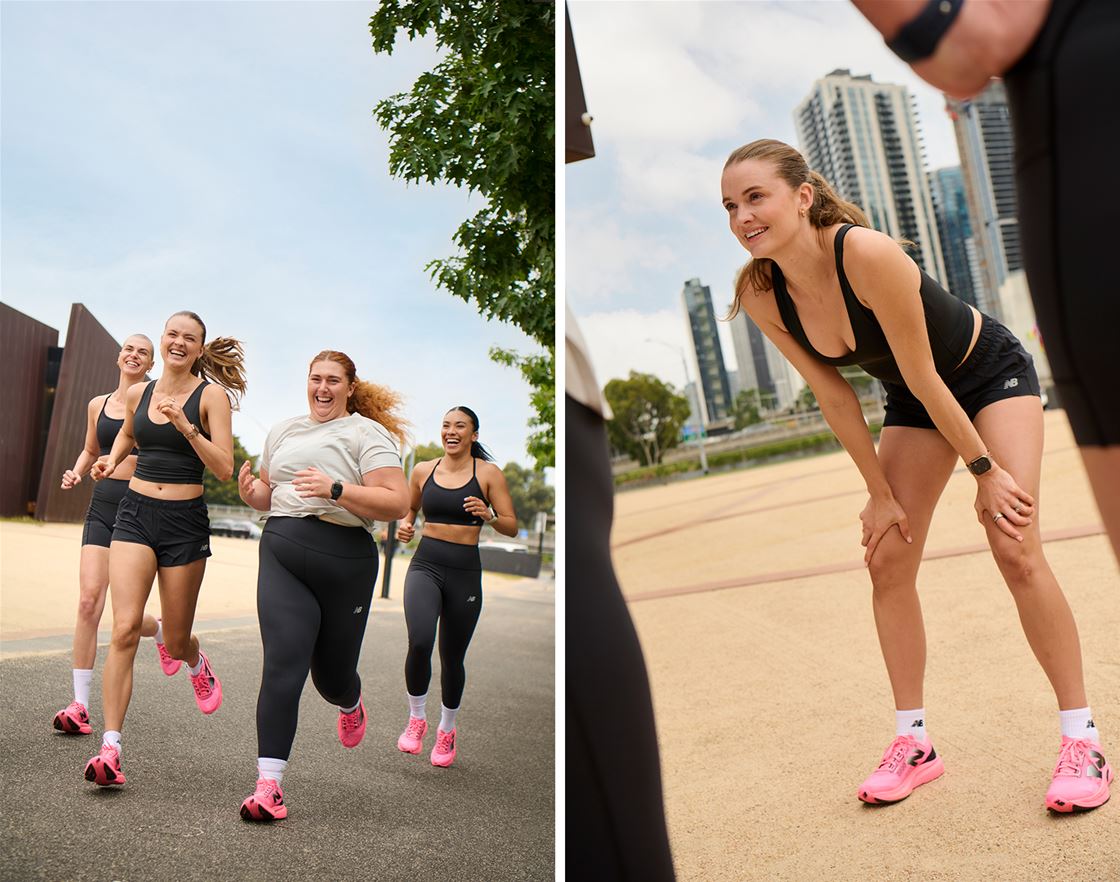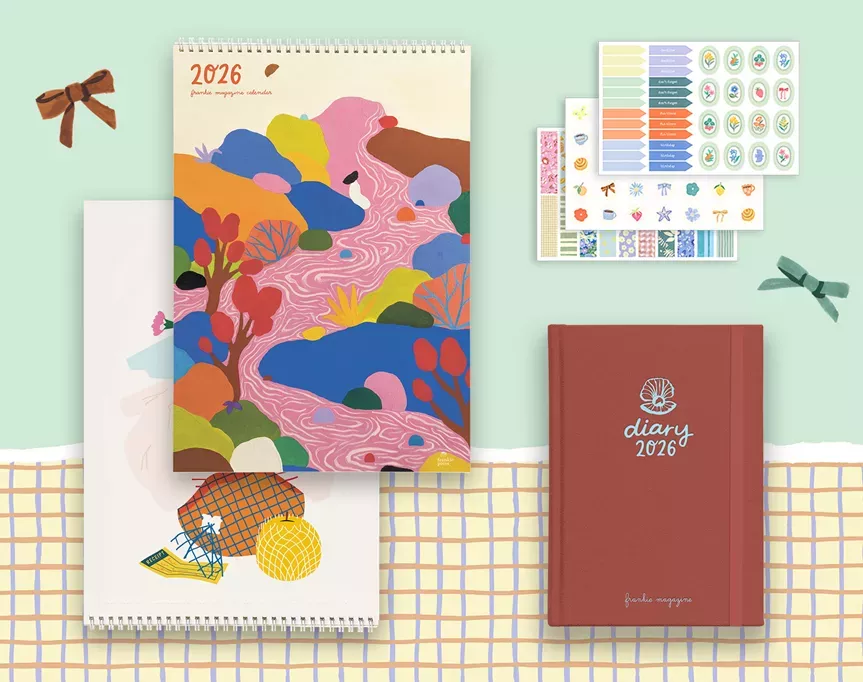laura henshaw’s tips and tricks for first-time runners
Laura shares her wisdom on how to be in it for the long run.
Co-founder and CEO of Kic (and incredibly enthusiastic runner) Laura Henshaw is no stranger to slapping her feet against the pavement. With only a handful of weeks to go until she runs in the London Marathon, Laura catches up with us for a chinwag to share her advice on how to get into running as a beginner. As a ripper lass that’s about to tackle a whopping 42.2 kilometres, Laura’s encouraging tips are for anyone struggling with the first 500 metres (guilty).
Tell us a little bit about when you first fell in love with running. I’ve (almost) always loved running. It was the first thing that taught me that the harder you work towards something, the easier it gets. But in all honesty, my running story hasn’t always been a positive one.
In my early 20s, I really struggled with body image – an obsession fuelled by social media and the pressures of the modelling industry. I felt this overwhelming fixation to make my body smaller. Running was my way of being in control – I used it to punish my body. I completely stripped away the pure enjoyment I would get from moving my body. It was no longer fun – it was no longer a privilege. At the time, I was pairing excessive exercise with restrictive eating habits – so I was exerting energy that I just didn’t have. I was exhausted and defeated, and it’s safe to say that I dreaded every coming run.
Society tells us that we should run to “burn off” or “earn” our food. But that’s NOT what running is about. I’ve learnt to rebuild my relationship with exercise. Now I run for the way it makes me feel – it has nothing to do with how I look. Now, running is a really important tool for my mental health and clarity, and a way to prove that I am capable of hard things!
Running can often be quite an intimidating activity to start for the first time as an adult – what are your tips on how to approach the first run for a newbie? A lot of that intimidation comes from how we perceive “runners”. We hold these limiting beliefs, like in order to call yourself a “runner”, you must run at a certain pace or distance, or look a certain way. But I’m a big believer that if you’re able to run, then you are a runner. No matter the amount of walking breaks, the pace, the distance – everyone is a runner as soon as they hit the pavement. Let go of these ideas and focus on the feelings you have when you run.
However, the first time you do something will always be a little intimidating. My biggest tip: start slow! Starting slow on your run not only allows your body to warm up properly, but it can help you with reducing injury and keeping up your running longevity. If you are running with a friend, you want to be able to hold a conversation while moving. And don’t be afraid to take breaks. The first run in our “0 to 5km” Kicrun program is 30 second runs, with 90 second walking breaks.
How important is it to own the right gear when you’re first getting into running? Whenever we start a new hobby, it can be SO tempting to go out and buy all the trending gear to go with it. But, honestly, the one thing I’d recommend investing in first is a really good pair of running shoes. Investing in the right footwear truly makes a world of difference – it can help reduce long-term injuries and things like shin splints. Everyone’s needs from a running shoe will be different, but using the right pair from day one is the best way to set yourself up for a safe (and fun!) running journey. Our community at Kic have been loving the New Balance Fuel Cell Rebel V4 as a versatile everyday running trainer. Starting with a more versatile shoe as a beginner helps you feel supported on your runs – no matter the pace or distance. However, it’s always best to get fitted for shoes IRL so you can see what’s best for you!
What are your suggestions on how to overcome the dreaded “wall” that runners can hit mid-run? The best (and sometimes worst) thing about running is that no two runs will ever be the same. Some days, I feel like I could run for hours on end, and other days I hit the “wall” after running for five minutes. How you feel on your run can be dependent on many different factors. Your menstrual cycle, the weather, how tired you are, how you’ve fuelled your body – it all has an impact! The point is, give yourself some grace if you hit that “wall” mid-run. It happens to all runners.
When it happens, it can be a good reminder to check in with yourself and how your body is feeling. Running is as much a mental sport as it is a physical one. Remind yourself that you can do this – your body is capable of more than you believe!
However, it’s good to keep in mind the difference between hitting the “wall” and knowing when you should stop. If you’re feeling faint or like your body is injured or in pain, this is a good time to slow it down to a walk. Do you need to be pushing yourself right now on this run? Take a moment to check in with your mind and body – if you need to stop, that is okay. All runners cut their runs short sometimes – it happens. Your health comes first.  For first-time runners, the repetitiveness of a run can be a little mind-numbing. Do you have any tips on how to keep your mind and body engaged (or entertained) during a run? Crank. Those. Tunes. Not having a decent playlist on my run will honestly make or break my vibe! I love popping together a playlist of songs that get me hyped and make me feel so damn good while I’m running. When the vibes are high, time can fly by so quickly on a run.
For first-time runners, the repetitiveness of a run can be a little mind-numbing. Do you have any tips on how to keep your mind and body engaged (or entertained) during a run? Crank. Those. Tunes. Not having a decent playlist on my run will honestly make or break my vibe! I love popping together a playlist of songs that get me hyped and make me feel so damn good while I’m running. When the vibes are high, time can fly by so quickly on a run.
Podcasts are a great option too – you do you! Sometimes just focusing on someone else talking about something you’re interested in can distract you from what you’re actually doing. If this is your vibe, guided runs can be a fab option too! In our Kic app, we have a range of guided runs which hype you up with tips and guidance at all the right moments. They’re perfect for beginners who may not want to be guided on their whole run, but still want some encouragement along the way.
If you’re someone who prefers to run without headphones, try changing up your running location! Explore somewhere new on your run, or – even better – time the end of your run to finish somewhere you’re meeting a friend. Lately my husband, Dalton, has been meeting me at the end of my long weekend runs at a café with our dogs. Knowing that I’m running toward brunch and a matcha latte makes the run feel that little bit more exciting.
Are there other exercises or activities that a runner should be doing outside of their runs to keep their body and mind fit? Adding in strength training to your routine can help you both improve your running, as well as also help reduce the chance of injury. Each time we run, we build our strength and endurance, but including conditioning in the mix helps strengthen those supporting muscle groups too. Everything works together to make your body move!
I recently picked the brain of Kic’s physio, Alana Murrihy, about this topic. She recommends including strength or Pilates training two to three times a week on days that you’re not running. The training style you should choose? Well, it should be whatever you enjoy!
Another huge tip is to not skip your warm ups and cool downs! I used to be a massive culprit of this, but trust me, it makes all the difference. Your muscles will thank you, I promise!
If there is one piece of advice you wished you knew when you were first getting into running, what would it be? Don’t be so hard on yourself! It’s easy to get caught up in the numbers – pace, distance, heart rate. But when you strip that away and focus on how good you feel while running, that’s all that matters. As I mentioned before, no two runs will be the same. Take the pressure off comparing your runs and look at each run as a new opportunity to grow and build your strength. The more you let go, the more you’ll start to enjoy it.












.jpg&q=80&w=316&c=1&s=1)













.jpg&q=80&w=316&c=1&s=1)










